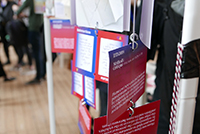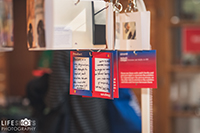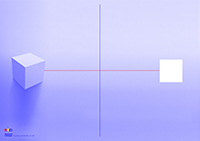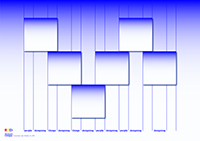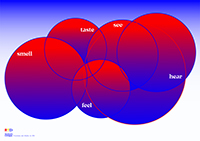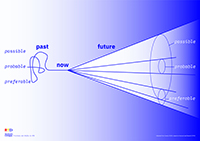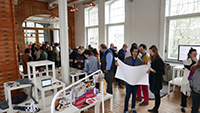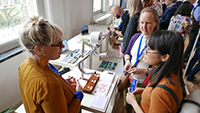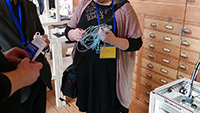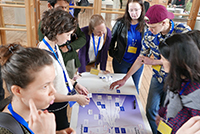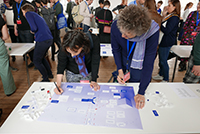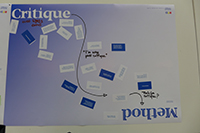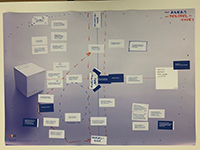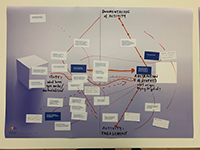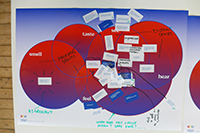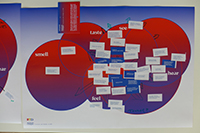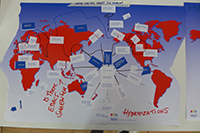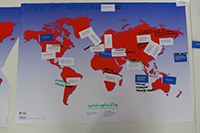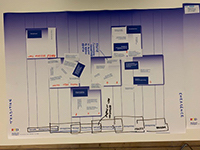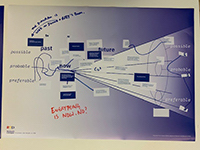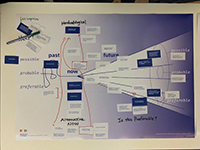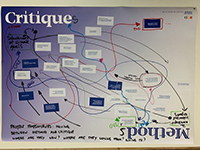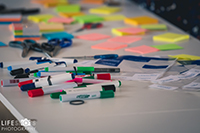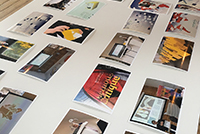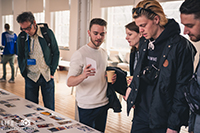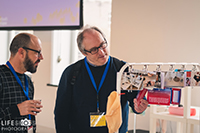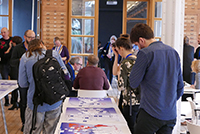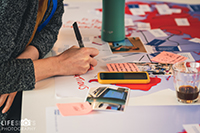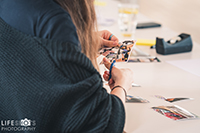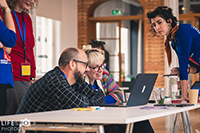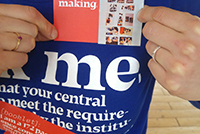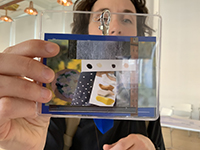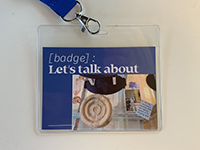PARTICIPATORY DOCUMENTATION
Participatory Documentation at RTD 2019
By Lenneke Kuijer and Abigail Durrant
Conferences are events where new ideas form, relations emerge, and where those with diverse and differing perspectives meet each other. Since the first edition, the RTD Conference series has critically explored innovative and experimental forms of documentation (see https://www.mitpressjournals.org/toc/desi/33/3).
Over the conference series, the RTD Documentation process has focused on actively capturing the unfolding experience of being at the event, and the rich discussions around presentations of work. At RTD 2015, this process was led by Scribes, contracted in a professional role to capture activity and expressions through n idiographic and interpretative lenses. At RTD 2017, the documentation materials incorporated attendees’ expressions, which were curated by the professional Scribes alongside their own ‘scribe materials’.
At RTD 2019 we continued to experiment with the active documenting of the conference, by taking a distinctly participatory approach that was anchored in three activities for attendees to engage with in the main programme. In this Blog post we report on those activities, and critically reflect on how they worked as methods of Participatory Documentation for RTD.
Participatory Documentation as RTD
A key goal for this participatory documentation was to scaffold researcher-practitioner reflexivity within the developing RTD community present at the conference. By taking an experimental approach, we also had a methodological aim, to explore new ways of capturing and communicating conference experiences for multiple audiences; and to provide a context for actively interrogating how Research-through-Design (RtD) is practiced and disseminated. We envisaged that those attending the conference would be the main participants in - and audiences of - the documentation, but also envisaged the possibility of there being other RtD audiences beyond the event who may engage with the materials.
It’s worth noting that there were other ‘Documenters’ at RTD 2019 who continued to experiment with scribing the conference in distinctive ways; this documentation is captured elsewhere; herein we focus on the three linked activities of participatory documentation that we led.
Annotation Cards
The first activity invited attendees to contribute reflections on the RtD work exhibited at the conference, focussing on its reception on the first day. Annotation Cards were hung in cascades from mobile rails that were positioned in the exhibition spaces. These Cards were pre-printed with provocations based on the conference themes, and included blank space to write in response. Attendees were provided with more of these Cards in their Conference Bags, and in the Conference Companion (booklet); and they were invited to document their reflections on the exhibition. At the opening plenary, attendees were told that the annotation cascades formed part of a broader participatory documentation process and would feed into follow-up activities, that the resulting ‘strings’ of annotations would be offered to the exhibitors at the end of the conference.
1. Annotation cards on their rails in the exhibition (photos Abigail Durrant and Lifeshots Photography)
The Annotation Cards idea did not work out as we envisioned. Relatively few annotations were added to the cascades over the course of the three days compared to expectations, and only a few sets were eventually handed to the exhibitors. We reflected that logistics played a role in this; the Annotation Cards that were included in the bags were not necessarily with attendees at the exhibition opening. Also, the place to attach the annotations was not always easy to find, plus attaching them required some fiddling. The mobile rails were often rolled into thoroughfares and could be obstructing people flow around the exhibits and presentations.
In terms of content, we reflected that the prompts on the cards may have been too directive. Attendees were unsure what the different terms meant or had remarks about the exhibits that did not fit any of the preprinted themes. Moreover, it may have been too much to ask for individual attendees to annotate specific exhibits. The set-up for the Annotation Cards did not allow for general reflections on the exhibition or other aspects of the conference by individual attendees. But for those who received a ‘string of annotations’, the Cards provided a conversational record of engagement by those attending.
Participatory Mapping
The second activity was called Participatory Mapping, which all attendees were invited to take part in during a dedicated session in the programme called ‘Making Space’. Making Space is an established feature of RTD that focuses on engagement with the RTD exhibition. It creates the opportunity for attendees to talk to exhibitors about their work and interact with it at their stand. Making Space is about 90 minutes in duration and forms a single track event in the programme. The Participatory Mapping activity helped structure the Making Space session for RTD 2019.
All attendees, including exhibitors, were organised into groups of approximately 12 members. Each group was presented with a template for a map on a table that the 12 participants could gather around. They were provided with pens, scissors and a sheet of sticker labels with the titles of the exhibits at RTD – these represented all presentations and workshops. Exhibitors were organised by the Chairs into two groups, Group A and Group B. For half of the session duration, Group A members were invited to move to stand with their exhibits and Group B would be doing the mapping activity; and vice versa. We acted as facilitators to introduce, explain, and coordinate the activity.
Each of the 12 groups was tasked with going into the exhibition, engaging with the work, talking with exhibitors at their stands, and then responding by using the provided stickers, pens and scissors to map the work onto the template. The groups were invited to self-organise for responding to the task.
2. The pre-printed maps
The activity arguably worked well to focus conversation, critical reflection, collective sense making, and knowledge exchange around the exhibited work at the conference. The maps and exhibition were located at opposite sides of the main conference space, but this didn't stop attendees from moving back and forth between them.
3. People talking to each other and showing work in the exhibition (photos by Abigail Durrant)
4. People working on their tables on the mapping (photos by A. Durrant)
Although some attendees felt at a loss for at least part of the activity and some disengaged, most were actively involved throughout. What we saw happening was that through the joint reflection on the exhibition – the heart of the conference -, the feeling of community among attendees seemed to grow. Many attendees seemed already ‘geared in’ to the notion of group-work from the start of the session, perhaps because many had previously taken part in workshops for the conference where the value of working together in interpretative activity around RtD artefacts and practice had been demonstrated and was evidenced.
Other than the Annotation Cards, this activity seemed to contain a fruitful balance between instruction and openness for the situation and setting. While the maps, stickers and activity structure pushed the groups into a certain direction, they felt free to be creative with it.
Intriguing maps were produced; these remained on the tables in a central space at the conference venue for the event duration, so that attendees could look at what each other had created, and reflect on the various expressions and interpretations of RTD 2019 captured in the resultant content. We have not, for now, engaged in depth with the content of the maps, but invite readers of this blog to take a closer look, bearing in mind the situated, haphazard and temporally restricted circumstances of their creation. More than an end in itself, the maps were primarily meant as a means to let attendees interact with the exhibits and each other.
5. All the maps resulting from the activity (photos by Caro Claisse and Lenneke Kuijer)
Sharing RTD
Sharing RTD was a participatory documentation session that took place on the morning of Day 3, in parallel with the Town Hall meeting. It was scheduled in a developing tradition of the Documentation debriefing on the last day, where attendees are invited to collectively reflect on their conference experiences. Maps and printed versions of photos were laid out on tables set out along a central space in the conference venue. Photos included those taken during the conference by us (the Documentation Chairs), plus those taken from the RTD Instagram and Twitter feeds.
6. Some of the materials made available for the activity in addition to those already present (Photos Lifeworks Photography and Lenneke Kuijer)
The idea of the session was for attendees to reflect on the conference by creating a keepsake in the form of a photo bricolage. To make this bricolage, they could use the printed photos, maps, their own new photos of exhibits captured ‘on the spot’ there and then, and anything else they'd like to add. Mini-printers were available in the room to support this activity. The photos were printed on sticker paper so they could be pasted for example on the conference badge.
7. Browsing the materials (photos by Lifeworks Photography, A. Durrant and L. Kuijer)
8. Making and printing bricolages (photos by Lifeworks Photography)
The participants who took part in the Sharing RTD session created thoughtful bricolages of the different provided materials, and wore the printed results on their badge. Participants seemed to really appreciate the printed conference photos and the opportunity to play with them as materials. And the quick, situated loop of taking and printing photos allowed by the mini-printers triggered creativity among participants (in particular the student volunteers).
In terms of its success in stimulating reflection, we found that those participating in the activity seemed immersed in carefully and thoughtfully creating their bricolage. Whether it succeeded in facilitating the sharing of this reflection is difficult to know because this happened outside of the scope of the activity and conference. A few participants deliberately did not print their photo collage because they felt their reflection was personal and did not feel comfortable sharing it.
9. Some results (photos L. Kuijer)
Closing Reflection
Overall, the participatory activities - involving collective interpretation and live reflection - feel like a worthwhile direction for RTD Documentation to experiment with. The Participatory Mapping arguably worked best; the activity generated a lively and vibrant mixing of individuals amongst exhibits, and meaningful, focused conversations. Taken together, the three participatory methods were problematic and led to disengagement for some people when elements were not clear in purpose (e.g. ‘why would we not populate a map of the world with the names of exhibits or exhibitors who are affiliated to a certain place?’), or when elements felt obstructive (e.g. in the very physical way that the mobile rails got in the way of people gathering around an exhibit). This is, perhaps, the risk that comes with doing anything interventional at a conference. We can highlight the challenge of conference design that is framed by RTD, whereby the documentation and dissemination of knowledge through the practice of making becomes a design problem, or a design exploration, or a design habit, in-and-of itself (see doi:10.1162/DESI_e_00446). The particular challenge in this context is being generative, and remaining critical (ibid).
At the RTD 2019 Town Hall meeting, discussion was raised about the richness of the workshops that took place on the conference eve; whilst the workshop outputs were included in the RTD exhibition it was recommended that they be referred to more during the conference event, through dedicated activities that ‘reconnect’ with workshop themes. Another idea raised at the Town Hall was to think about about facilitating knowledge exchange more explicitly in the Making Space session in terms of (echoing the spirit of the workshops) constructing knowledge through making in the room (and including mini pop-up workshops). Ideas like this should, in our view, be nurtured and kept alive to be experimented with in future editions of the conference.

